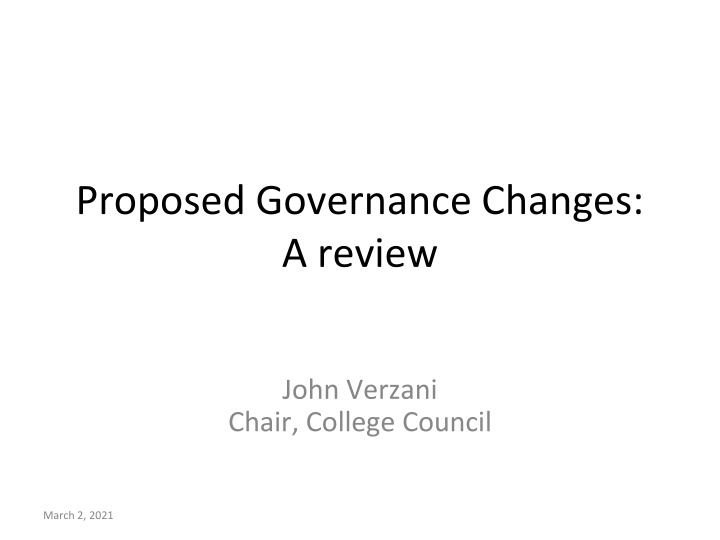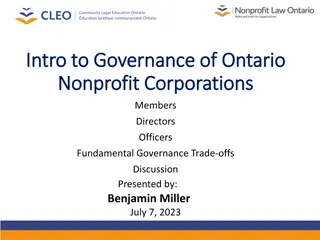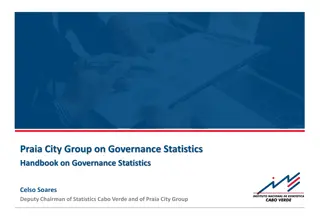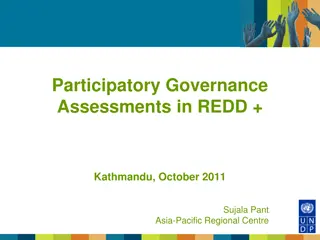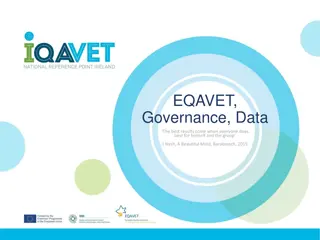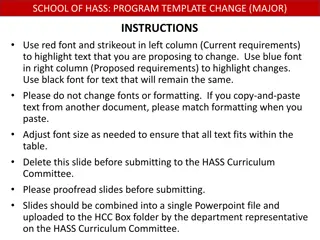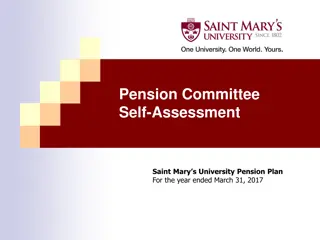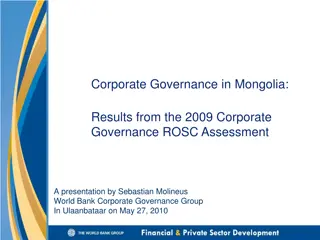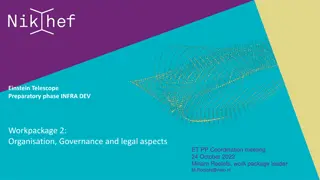Proposed Governance Changes Overview
The proposed governance changes include revisions to the College Council structure, role of college officials, and consultative committees. Key alterations involve the CSI College Senate, committee leadership, and the P&B committee composition.
Download Presentation

Please find below an Image/Link to download the presentation.
The content on the website is provided AS IS for your information and personal use only. It may not be sold, licensed, or shared on other websites without obtaining consent from the author.If you encounter any issues during the download, it is possible that the publisher has removed the file from their server.
You are allowed to download the files provided on this website for personal or commercial use, subject to the condition that they are used lawfully. All files are the property of their respective owners.
The content on the website is provided AS IS for your information and personal use only. It may not be sold, licensed, or shared on other websites without obtaining consent from the author.
E N D
Presentation Transcript
Proposed Governance Changes: A review John Verzani Chair, College Council March 2, 2021
At a glance The proposed wholesale replacement has many deviations from our current practice as to make a summary difficult. I have summarized them here as best we can for a 10-minute discussion. There are 3 supplemental documents for a more thorough break down at https://csi-covid19.github.io/CCFS/Mar- SpecialMeeting/
The process used for approval is an outlier in our history Quoting from a 2009 letter then Provost Fritz sent to then By laws Committee Chair Sandi Cooper: Language in a governance plan takes on charged meaning and even small, seemingly inconsequential changes, can have profound implications. Here we can agree. The president took 12 months to review and approve (just this Winter) a short collection of modest proposed amendments to the governance plan the Bylaws committee had worked for year or so.
Changes to the role of the president, provost, and cabinet The College Council and Faculty Senate would be replaced with a CSI College Senate, which plays both roles, though primarily that of the College Council. The committee structure is completely revamped The CSI College Senate would have no elected leadership; the president would be its chair The standing committees are all chaired by either the President, the Provost, or a designee. There are no elected chairs. The entire cabinet becomes a member of the Senate, save the Chief of Staff The executive committees of the College Council and Faculty Senate are elected by the bodies; the executive committee of College Senate is composed of the President, Provost, Chief of Staff, possibly appointed ( taken not elected ) faculty members (though as written, these could be deans), and one HEO (again taken not elected )
Changes to the consultative nature of many committees The elected College Council Executive Committee, which meets monthly with the President and Provost, for consultative meetings is abolished. The elected Faculty Senate Executive Committee, which meets monthly with the Provost and Academic Deans for consultative meetings, is abolished. The Institutional Planning Committee, which offers elected faculty a chance for meaningful participation with the President and other cabinet members about the direction and mission of the college is abolished The College Council Budget Committee is abolished
P&B changes The current College P&B voting members consisting of the 25 chairs is replaced with a committee with just 5 faculty; 2 students; 5 deans; the CFO, Provost and President. Faculty voice is limited to only 5 of 15 votes Divisional/School P&Bs are proposed but their composition is not defined, including who is the chair
College P&B President, Provost, CFO, 6 Deans, 5 chairs ,& 2 students Dean Div/Sch P&B Dean HSS + 9 chairs Dean ST + 6+? chairs Dean SoE + 2 chairs Dean SoB+ 4 chairs SoHSc + 3 chairs Departments English Biology Curr & Inst Acct & Fin Nursing Phys Therapy History Chemistry Educ Stud Economics Social Work Med Cult Comp Sci Marketing PCA Eng & Env Mgmt Philosophy Math PS&GA Phys & Ast Psychology Library ??? Soc & Ant WL&L
The curriculum approval process changes Each Division/School would have a curriculum committee. These would be chaired by Deans. The plan mandates 55 faculty be involved at this level, up from 26 in the current model. Unlike the Faculty Senate where Decisions are forwarded to the Executive Committee of the Faculty Senate for review and action by the Faculty Senate, proposals are forwarded to the College Senate for review and submission to the President for approval. (This does not imply approval is necessary.)
General Education changes The General Education Committee with 25 potential faculty members is abolished. The proposed Curriculum and Articulation committee consists of Two faculty member [sic] elected from each division/school (elected by the entire faculty, as written); an associate provost, the academic deans, the registrar, two students, and the provost, as chair. Review isn t expected: Recommendations are forwarded to the College Senate and submitted to the President for approval.
Subcommittees to Standing Committees The Faculty senate has numerous subcommittees; this proposal has numerous standing committees. The reporting nature is not the same: Currently: None of the Faculty Senate committees are policy-making bodies, and all recommendations made by such committees are subject to review for further action in accordance with the Governance Plan, except that decisions related to individual students are final. Proposed Admissions Decisions of the committee may be appealed to the Provost. Assessment and Institutional Effectiveness (no reporting given) Research Makes recommendations to the provost. Student Affairs Reports will be made to College Senate. Recommendations may be appealed to the President. Student Evaluation of Courses and Teaching ditto Technology ditto
Term limits These committees have significant restrictions on who can serve, as compared to the current practice The term of service for all college, division/school and department committees shall be two years. No person shall be elected to more than two consecutive two-year terms on any committee. Members may stand again for election after a two-year interval. No person shall be elected to serve simultaneously on more than one college- level standing committee.
Reduction/reapportioning of faculty voice on areas of primary responsibility The faculty has primary responsibility for such fundamental areas as curriculum, subject matter and methods of instruction, research, faculty status, and those aspects of student life which relate to the educational process. (AAUP Statement on Government of Colleges and Universities ) Administrative Chairs replace elected chairs Replaces the careful balancing of faculty from Division/Schools The Academic Freedom Committee is currently selected by the Faculty Senate Executive Committee; the proposed new committee would be selected by the Deans. Faculty Personnel Policy Committee is abolished
Removal of many other important College Council functions The AREC committee with its oversight duties is abolished The Committee on organization is abolished The Bylaws committee is abolished. Though the referendum process is similar in wording, the Student voice on any change is proposed to be 2/71 instead of 8/74; the PT faculty voice is removed; the HEO/CLT voice is diminished
Upon first read of Proposed Plan, you may think its College Council College Senate Faculty Senate
A closer read of Proposed Plan Renamed & revamped Faculty Senate Committees (minus 2) College Senate + 12 standing committees Plus 3 new committees
Abolished committees of the CC Administrative Review & Evaluation committee Institutional Planning Committee Budget Committee College Council Facilities (in part) Bylaws Committee Committee on Organization
Abolished 2 committees on FS Research (kind of) Faculty Senate Faculty Personnel & Policy
Three new committees Assessment and Institutional Effectiveness College Senate Student Evaluation of Courses & Teaching Student Affairs
The proposal has many technical issues, e.g.: The membership of the executive committee of the CSI College Senate is deliberately vague. All members may be appointed by the President, as written. The non-chair faculty membership of the CSI College Senate could possibly be appointed, as no mention of an election is given. The HEOs on the CSI College Senate are not elected, nor necessarily members of the Steering Committee. The administrative portion of the votes on the CSI College Senate can grow significantly in proportion; all other bodies have a fixed size. The Divisional/School Personnel and Budget Committees are not specified; the chairs which play a significant role in the P&B may presumably be appointed. The Departmental Appointments Committees are abolished and their duties not assigned. The Division/School representatives are elected by members from all the voting faculty. The allocation of faculty voice in all committees does not reflect the size of the body they represent. Where faculty have primary responsibility for matters of status, the proposed P&B has only 5/15 votes as faculty. And as mentioned these may possibly be appointed. ...
Please participate The President has arranged for commentary to be held through TEAMS. The link in the 3/2 email initiates membership in the group. Unlike past uses of community bulletin board, there is apparently no means to post anonymous commentary. The fear of retaliation is always present when interacting with a College President. If you have such a concern, I have offered to post comments sent to me (jverzani@gmail.com) to the TEAMS site.
